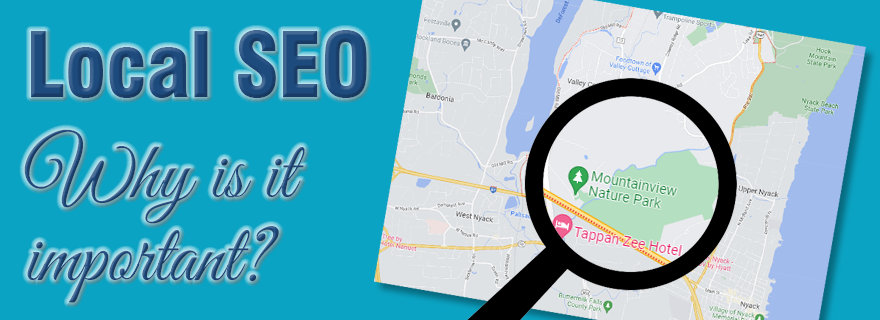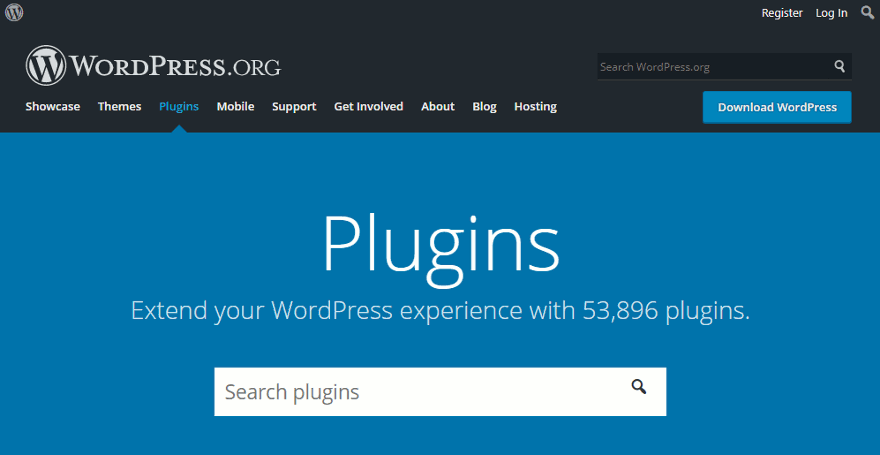If you run an online business where your customers come from around the area you’re located in, keep reading. We’re going to lay out why Local SEO is important and is likely the best way for you to improve your website performance and get more customers from the surrounding towns and cities.
Before we dive into the technical side of Local SEO you should understand one very important fact that’s overlooked by many local business owners. Optimizing for local traffic is one of the most effective steps in SEO. It provides an excellent return on investment of time and money, yet it is ignored by many local site owners. Chances are once you understand why Local SEO is important, optimization will make a big difference to your competitiveness in SERPs (search engine results pages).
Today we’re going to tell you what Local SEO is, how it works and how you can rank your business to get more customers through the front door. Use the links below to jump back and forth as you read.
Local SEO basics
It’s important to understand what Local SEO is and how it differs from traditional SEO aimed at organic rankings.
First and foremost, local SEO is almost entirely a Google phenomenon. It is optimized for Google users, so if you don’t already have a Google account get one now.
What is Local SEO?
Local SEO prioritizes your website and other online assets to attract more attention from local searches. It is coupled with Geo-positioning (your GPS location) on smartphones and computers to offer the product or service searched for from companies within a radius of a few miles from the location of the searcher.
Why is local SEO important?
Put simply, almost a third of all searches are Geo-located. When people search for a business, the default search condition on smartphones is [keyword] + [near me]. Try searching for electricians or sports bars in Google and you’ll see businesses local to you popping up at the top of search you probably recognize.
In the most current version of their How Mobile Search Connects to Customers document, Google states 30% of all mobile searches involve location, and nearly 80% of folks who search for a nearby service or product visit the store within 24 hours. Conversion of visitors to customers is almost 30%.
This is of course very logical. Searchers looking for a product or service are usually highly motivated buyers. If a simple search shows they can get what they need just a few miles away it stands to reason they’ll hop in their cars and go get it. That’s the real power of local search results and if your website isn’t ranking in search near me you’re likely missing out on a lot of business.
How does local SEO work?
Local SEO is an extension of standard organic SEO, so it makes sense that both local and standard organic results can be seen on the same page. No surprise, some companies rank very well in both. The main difference between the two is the local SERPs display near the top of the first page on Google. This is often referred to as the map pack or local pack.
Map pack results
Our company MPR Studio ranks well in local search and can be seen prominently displayed at number 1 in the map pack for searchers looking for web design services in our part of New York.
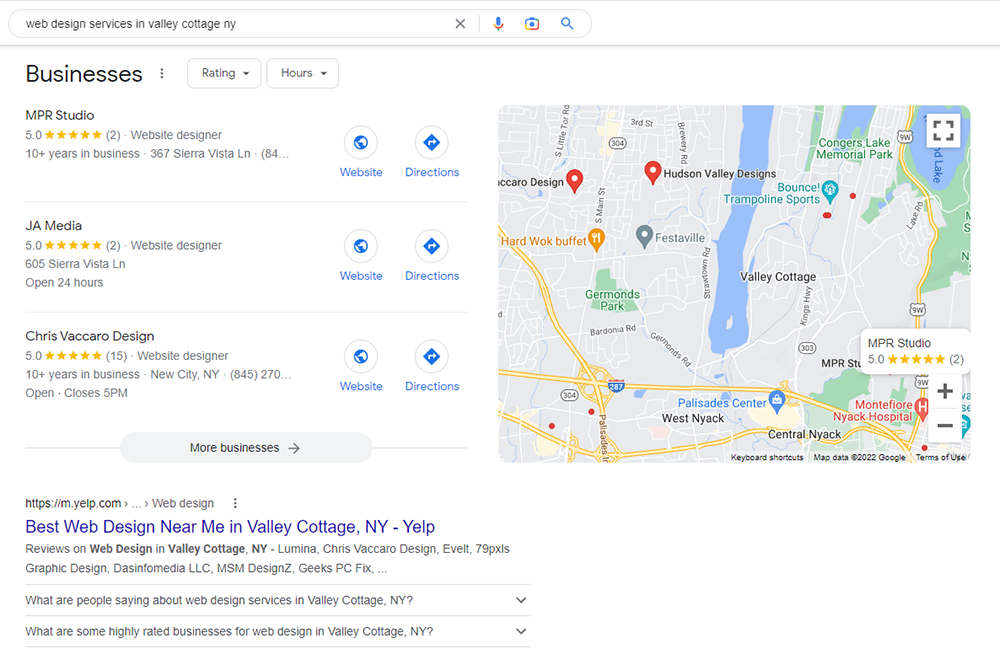
Organic search results
The organic search results almost always appear immediately below the local pack. These are the blue links we all know well. Ranking for both local map pack placement and organic placement is the ideal outcome of any SEO campaign. Concentrating SEO efforts on the easier local SEO work actually helps with organic SEO too, so it’s possible to bias for local improvement and still improve organic results. The general rule to follow is if you have a bricks and mortar business, or if your web-based products are sold in only one city or county, optimize for local SEO first and you’ll naturally improve organic search results in the process.
Local SEO keyword research
One of the more misunderstood, or perhaps better stated as badly interpreted SEO functions, is keyword research. It’s relatively easy to find keywords that are related to your business, but much more difficult to add the context a searcher might use those keywords in when looking for your product or service.
According to Google, nearly 80% of all mobile searches with [keyword near me] result in a visit to a store, so in local keyword research it’s vital to target searchers with keywords related to the outcomes they expect when they come to visit. When doing keyword research, it’s therefore very important to put yourself into the mind of the typical searcher for your products or service.
Let’s say you’re a hardware store. A searcher might find electrical wire of a certain gauge they’ve been looking for on your site. Can you guarantee they will find it when they come to your store? If not, your local searcher will be very disappointed.
Local keyword research is the art of understanding how people search for local services. Getting it right will set you up above and beyond most of the local competition.
Find keywords that fit your service
Finding service-based keywords becomes a lot easier when you put yourself in the position of the searcher. One of the best ways to do that is to open your job records and write down your most common customer requests.
Let’s say you run a plumbing business. Searching for plumber on Google will result in very general responses, which may be good enough, but many customers will find you by searching for more specific keywords. This is classic long tail keyword country and you’ll find a close correlation with the job descriptions you’ve worked on and the searches made by prospects on Google. Get to know what works for you and other local businesses then code those keywords into your content to make sure you rank for them.
For a plumbing business, those long tail keywords might look like:
- Drain unblocking
- Water heater repair
- Water heater installation
- Boiler servicing
- Radiator pump installation
- Burst pipe repair
Once you have a list of keywords that fit well with your business and have decent monthly search volume on Google, you can use them as ‘seed keywords’ to drill down further into related search terms being made by your prospective customers.
The simplest method of doing that is to enter each of the keywords into Google search and examine the list of related keywords that appear under the search entry window. Capture these then click Search. At the bottom of the first page you’ll see ‘Related Searches’ with similar search terms. Incorporating the most relevant of these similar keyword results into H2 headings in articles and blogs is a great way to tell Google about every angle you’re covering on the main topic.
There are a few excellent paid tools out there that provide more sophisticated local keyword research options. Check out Ahrefs and Moz keyword explorers. These are spendy tools, but they offer great insight into how your website is performing with respect to your local competition.
Check search volumes
We are interested in local SEO, so we’re going to have to find a method to estimate local traffic, not the national traffic estimates given by search tools. One of the easiest ways to do that is to use Google Keyword Planner. This lets us set the city we’re interested in traffic for individual keywords. Unfortunately, it’s also pretty generic and only provides bracketed traffic extremes (10 – 10k) for each keyword, not individual volumes. Is there a better way? You bet!
Steal your competition’s keywords
At MPR Studio we use Ahrefs to hone in on the keywords we want. Let’s imagine you are an electrician in Houston, Texas and let’s say you want to expand your service offerings into data network wiring. Electrical and data network wiring are very complimentary services and come up together in many commercial and high-end residential construction jobs.
To find keywords that really drive local sales in this category, do a search for [data network wiring] in the Houston area. That will give you the top local companies in the map pack, and the top organic search company. Note in many cases, the top organic company will have a substantially better performing website than the ones in the map pack, so you can usually guarantee their keyword selection has been made after significant study of the benefits of ranking for that selection.

Next, examine keyword performance for these sites and look for the lowest level of competitive difficulty. In Figures 3 & 4 below, column KD (keyword difficulty) indicates several fairly easy keywords (KD<25) that could be used to boost our electrician’s site for keywords related to [data network cabling].
This result shows something that’s peculiar to map pack ranking: the site has poor organic rank and gets no traffic from its selected keywords, but because of its location, and its domain name, it still ranks high in the map pack.
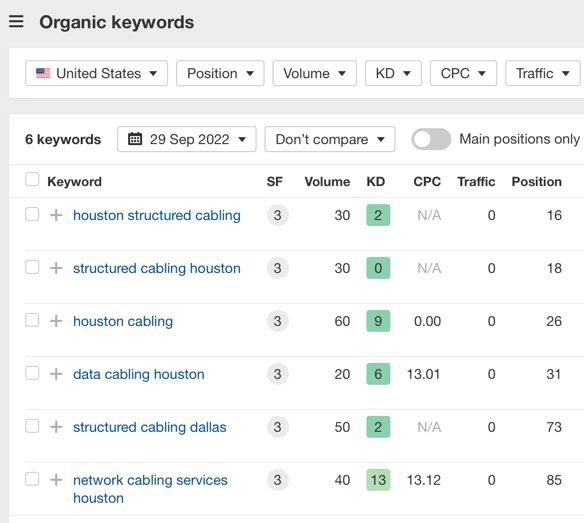
The best organic search site shows what most would agree is the expected keyword performance for a site ranked at the top of Google SERPs. It has good traffic and position across a wide range of related keywords.
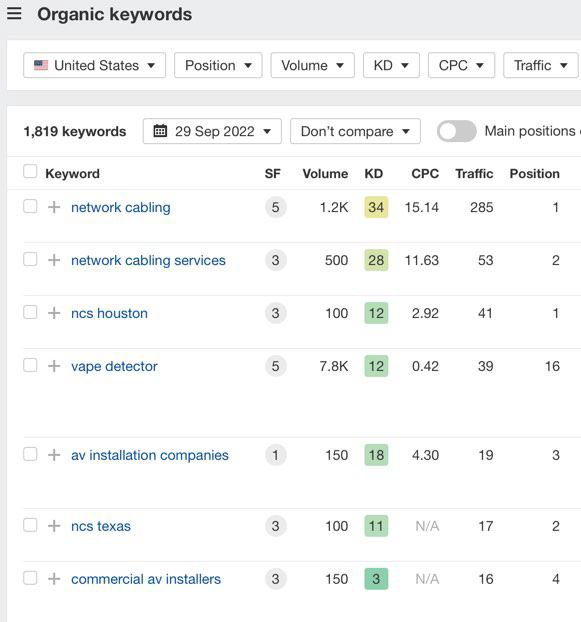
Our electrician looking to expand his search performance into network cabling services now has several keywords he can choose to create content with. In our opinion, the process of finding keywords competitors rank for is more streamlined than the generalist keyword research approach and gives a straight-line comparison between your own company and the one you’re trying to beat in search. It stands to reason if they do the same type of work you do, and they are ranking above you in search, using their keywords will make a difference in your own SERPs. That’s especially true if your aim is simply to get into the local map pack.
Does your keyword have Local Intent
It’s pretty easy to figure out if your keyword has Local Intent. By definition it means local searchers want to shop for this service or product nearby. A Google search should return a map pack and the standard organic results. If the map pack is not present, it has no local intent.
From our previous [network data cabling] example it’s clear there’s local intent in the Houston area for this keyword. See Figure 5 below.
One of the more frequent questions we get asked as local SEO experts is whether it’s worth adding content for keywords that don’t have local intent. The answer can be a bit subjective, but at MPR Studio we always say it’s a good idea, but with set conditions. It boils down to whether the keyword in question is supportive of the main local keyword you’re trying to rank better for.
For example, a therapeutic massage site might rank in the map pack for [healing massage]. There likely isn’t local intent in keywords like [massage oil] or [massage table] but creating content with those keywords can help support the overall message the business is trying to get across to both the search engines and undecided prospects reading content on the website. Writing pieces on both of these topics allows linking internally and to external sites that supply tables and oils and can lead to backlinking opportunities from that same group of suppliers. Google loves this type of thinking and rewards sites in SERPs accordingly.
The best approach is to think of local intent keywords at the top of a pyramid supported by several related keywords in the structure underneath.

Create content pages with keywords
Something that’s easily overlooked at the end of the keyword research process is mapping your keywords to particular web pages. Why is this important? Imagine how difficult it would be to go into a grocery store you don’t know and find there’s no signage telling you which products are on which shelves. Worse still, there’s no logical order to where any of the store’s goods are shelved. It is very common to have a version of this on websites. To make sure your site isn’t one of them, start to think like the people landing on your site. What did they search for? Which landing page did you send them to? Do they see a version of their search term as a title on the landing page? If the answer to all of these questions is ‘Yes!’ the chances are very good your visitor will stay and proceed to the next phase of the sales funnel. If the visitor lands and is confused or doesn’t immediately see something relevant to the search term she typed, she’ll bounce off in seconds. There are few guarantees in SEO, but unfortunately, that’s one of them.
Spend time mapping each of your keywords to pages where they support the content. A good method of checking whether individual keywords need their own page is to run a Google search and see if SERPs return with pages addressing this keyword explicitly. Those that do should be regarded as major keywords on your site and have their own pages. Those that don’t should be placed in pages that support the closest major keyword.
Local SEO ranking factors
Local SEO is a creation of Google designed to take advantage of the fact that the majority of searchers prefer to give their business to local companies whenever possible. It has been incredibly successful for small, local companies who could never hope to rank organically against national competition. Thanks to Google’s definition of Local Intent, local buyers can now see local companies displayed at the top of Google SERPs.
Because Local SEO is a gift from Google which also clearly benefits Google, there are rules that need to be followed by local websites in order to play the game. There are also individual ranking factors that affect local map and organic search individually. As we said at the top of this article, it is a great goal to rank in both organic and map pack searches. For most however, getting into the map pack (and staying there) is the primary goal of Local SEO. Let’s take a look first at ranking factors for Local SEO.
Google Business Profile
In 2022 Google change the name of Google My Business to Google Business Profile. A Google Business Profile is a free local listing with information about your business that allows Google to place you on Google Maps and the map pack. Remember this is a service by Google, for Google so if you aren’t part of the Google family you can’t participate in Local SEO. Setup your own Google business profile if you don’t already have one.
Key items included in a Google Business Profile are:
- Your business name
- Your business category
- Your business hours (including holiday hours)
- Your physical address
- Your service area if you visit or deliver to local customers and clients
- The products or services you offer
Remember, this is one ranking factor you must have if you want to rank in the local map pack, so get a Google Business Profile.
It’s worth reading Google’s own advice on how to get the most out of your profile. Best practices include adding photos and customer reviews.
NAP citations
Name, Address and Phone number, or the NAP citation is how your site’s business’s name, address, and phone number appear, and are proliferated online. As a ranking factor in and of itself, most SEOs agree the NAP citation is less important than it used to be. However, the fact that your NAP will propagate quickly means it’s very important to make sure all of the details are exactly correct. If people can’t call you because there’s a 5 instead of a 6 in your NAP phone number, you’ll lose business. As an incentive to check twice before submitting, imagine what it might be like to track down 200 of your citations and change the phone number manually…
Other Business Citations
These can be some of the easiest assets to work on for low cost 3rd parties since they don’t require any intimate knowledge of how your business works. For that reason alone, many site owners employ contractors to garner whatever citations they can. Why? Citations help prospects and other companies find your business online. Many of the referral sites like Yelp and Thomas rank at the top of Google for local service searches. If you are listed in these directories, you’ll get exposure to any search won by the referral site.
Building Citations: What you should do
- Get listed with Data Axle, Localeze, and Foursquare. These are the big 3 data aggregators and they will help get your citations out there.
- In the US submit to Apple Maps, Yelp, Yellow Pages, Bing Places, and Facebook.
- Submit to other popular directories in your local area and industry.
- It is very important to keep your citations consistent. Use the same NAP everywhere.
Ahrefs has a great article on this: How to Build Local Citations
Reviews
Love them or hate them, reviews are here to stay, especially in the world of Local SEO. The quantity and quality of reviews on your Google Business Profile is increasingly seen as a major quality marker. Reviews don’t necessarily play an important part in map pack ranking as is easily exemplified by results. It’s very common to see sites with many 5-star reviews at positions 2 and 3, and a site with no reviews at position 1.
What’s crucial about reviews isn’t their effect on ranking, it’s their effect on buyer trust. The more ‘good’ reviews a product, company or service has, the more comfortable buyers are moving forward with purchases. The map pack presents a visual case for that argument which is simply undeniable.
Look at Figure 6 below. What order would you visit these sites if you had searched for [bakery walker mn]? Many would say 2, 3, 1 because there’s no proof shown that the site at position 1 has had any satisfied customers. The lack of trust is tangible and can have a huge impact on conversions. In local SEO, ask for reviews from your customers and make sure they appear on your Google Business Profile.
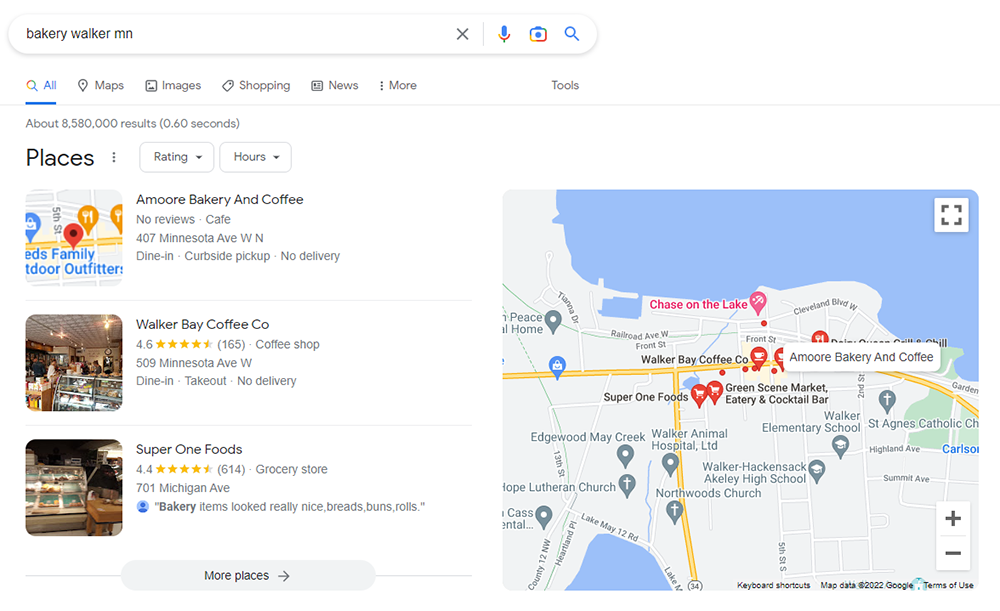
Backlinks
Technically this should really be titled ‘Links’ since links inside the website and outgoing links to other sites are also important for site ranking. Backlinks are however the daddy of them all and are rightly given the highest value of importance by most SEOs. They are less important in local SEO however, simply because competition is so much lower. Almost every website with a physical address in a city of 100,000 people will be seen at some position in local search, while only those with content verified by many backlinks make it to the top pages in national organic search.
This is an article describing tactics to boost Local SEO, but we should note that Google’s current algorithm has backlinks as one of the top three ranking factors. That makes getting backlinks a key priority for all content, whether it’s for local or national consumption. Put simply, any worthwhile backlink will enhance the rank potential of a website in national or local searches.
One of the best charts ever created for website owners who doubted or misunderstood the benefit of backlinks and their referring domains was created by the research team at Ahrefs. It’s shown below in Figure 7 and shows backlinks versus organic traffic. Note it has a 0,0 start point, meaning if there are no backlinks on your content you will get no organic traffic. This chart has been verified across billions of pages. Bottom line… get some backlinks for all the content you develop if you want anyone to see it online.
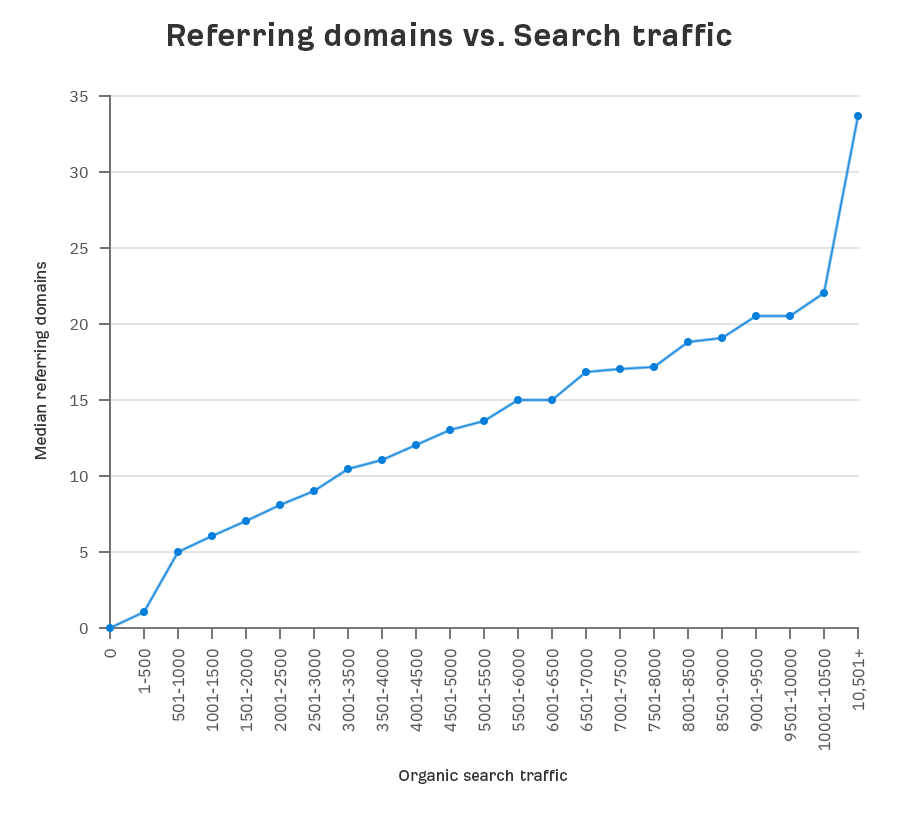
On-page SEO
We’re saving the best for last on Local SEO. That’s because on-page SEO has become a nuanced version of its old self that many of your competitors, especially those who do not have expert SEO guidance will overlook. On-page SEO has a huge impact on both ranking and conversion.
In Local SEO it has become much more important to tailor pages specifically to local interest than to simply talk about the product or service. It comes back to the notion of local searchers feeling that the website they have landed on is indeed local.
Think of TV news shows for a second and try to visualize the scene they set up behind the news crew when they’re talking national politics. It’s almost always the Capitol in Washington DC. The background gives viewers a visual indication that they are watching what they want to see.
It’s the same with local websites. Instead of just adding images of products, add a few photos of unmistakable local points of interest and tag them so that Google knows what it is and where the pic was taken. If you have a physical store, make sure you have photos showing it from every angle and include views to different streets you can also tag.
Next, make sure your pages show local intent. If you need a refresher on what that means, check the section on Local SEO Keyword Research and make sure the services or products you want to sell locally have enough local interest.
Finally, include information that matters to searchers. This is true search intent. Find out what they want to see on your site. Ask questions, send out easy surveys to past customers and ask them how you could improve your site for them. It should be no surprise that we all get bombarded with requests like this from everywhere we go online, because just a few responses can make a major difference to how a landing page converts visitors. Personal feedback is one of the best SEO gifts you will ever receive, so go after it unabashed and make your site more like the one your customers want you to have.
Conclusion
Hopefully after reading this guide, you have a better understanding just how important Local SEO is, and how optimizing your site for your local area can boost traffic, increase quality leads and help your business make more money.
If you have any questions or comments, please leave them below and we will try to help you out.
Want more like this? Sign up for our newsletter to receive helpful WordPress Tutorials, Tips and Tricks.

